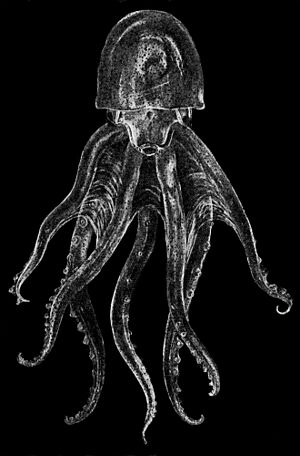Glass octopus facts for kids
Quick facts for kids Glass octopus |
|
|---|---|
 |
|
| Belly view of female | |
| Conservation status | |
| Scientific classification | |
| Genus: |
Vitreledonella
|
| Species: |
richardi
|
| Synonyms | |
|
|
The glass octopus (scientific name: Vitreledonella richardi) is a super cool and mysterious creature that lives deep in the ocean. It's called the "glass octopus" because its body is almost completely clear, like glass! This makes it very hard to see in the dark waters where it lives. This amazing animal is a type of octopus that doesn't have a hard shell.
Meet the Glass Octopus
The glass octopus is a see-through, jelly-like animal that lives in the deep parts of tropical and subtropical oceans all over the world. Because it lives so far down, it's very rare for scientists to see one in its natural home.
One of the most exciting times a glass octopus was seen was in 2021. Marine scientists from Boston University were on a research ship called the Falkor. They managed to film two glass octopuses, which was a very special moment!
Adult glass octopuses can have a body (mantle) up to 11 centimeters (about 4 inches) long. Their total length, including their arms, can reach up to 45 centimeters (about 18 inches). Their top three pairs of arms are usually about the same length. The fourth pair of arms, which are underneath, are a little shorter.
The suckers on their arms are small and spaced far apart. They are arranged in a single line. Male glass octopuses have a special third arm on their left side. This arm is used for reproduction.
The eyes of the glass octopus are quite unique. When you look at them from the side, they look like rectangles. This special shape helps the octopus to hide. It makes their eyes look smaller when seen from below, which is a clever way to stay camouflaged in the deep ocean.
Life Cycle and Reproduction
The glass octopus has a special way of reproducing. The female keeps her eggs inside her body until they hatch. She can carry hundreds of tiny eggs inside her mantle. Each egg is about 4 millimeters (less than half an inch) long.
When the baby octopuses hatch, they are very small, only about 2.2 millimeters (less than a tenth of an inch) long. These tiny babies are called paralarvae. Sadly, the mother octopus usually dies soon after her babies are born. The young paralarvae must then take care of themselves.
Scientists have studied how these young octopuses change as they grow. They found that young paralarvae have stronger beaks. This helps them tear apart the prey they eat when they are very young. As they get older, their beaks become less developed. This is because their diet changes to softer foods.
As their diet changes, they also move to different depths in the ocean. Younger paralarvae live deeper, usually between 310 and 440 meters (about 1,000 to 1,400 feet) down. As they grow older, they tend to move up to shallower waters, between 110 and 300 meters (about 360 to 980 feet) below the surface.
Where Do They Live and What Eats Them?
Glass octopuses are found mostly in the warm parts of the oceans around the world. They live in both tropical and subtropical regions.
In the deep ocean, the glass octopus can become food for other animals. One of their main predators is the Northern bottlenose whale. These whales hunt and eat glass octopuses as part of their diet. Scientists have specifically noted that a whale named Tåsinge often eats them.


